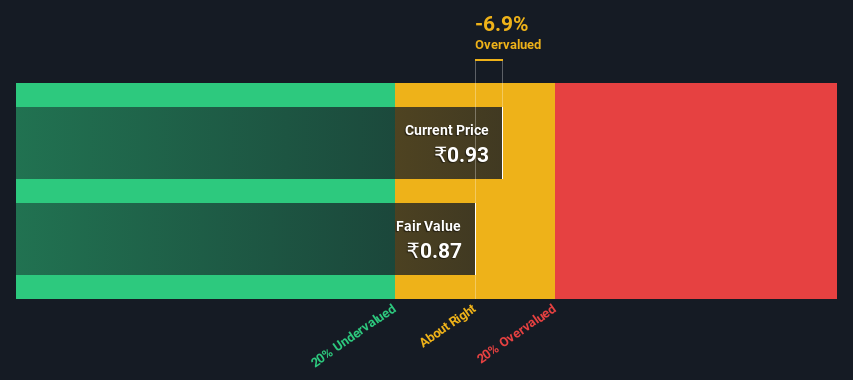Estimating The Intrinsic Value Of Visagar Polytex Limited (NSE:VIVIDHA)
Key Insights
- The projected fair value for Visagar Polytex is ₹0.87 based on 2 Stage Free Cash Flow to Equity
- Current share price of ₹0.93 suggests Visagar Polytex is potentially trading close to its fair value
- Visagar Polytex's peers seem to be trading at a higher premium to fair value based onthe industry average of -3,380%
In this article we are going to estimate the intrinsic value of Visagar Polytex Limited (NSE:VIVIDHA) by projecting its future cash flows and then discounting them to today's value. We will use the Discounted Cash Flow (DCF) model on this occasion. It may sound complicated, but actually it is quite simple!
We would caution that there are many ways of valuing a company and, like the DCF, each technique has advantages and disadvantages in certain scenarios. If you still have some burning questions about this type of valuation, take a look at the Simply Wall St analysis model.
Crunching The Numbers
We are going to use a two-stage DCF model, which, as the name states, takes into account two stages of growth. The first stage is generally a higher growth period which levels off heading towards the terminal value, captured in the second 'steady growth' period. To start off with, we need to estimate the next ten years of cash flows. Seeing as no analyst estimates of free cash flow are available to us, we have extrapolate the previous free cash flow (FCF) from the company's last reported value. We assume companies with shrinking free cash flow will slow their rate of shrinkage, and that companies with growing free cash flow will see their growth rate slow, over this period. We do this to reflect that growth tends to slow more in the early years than it does in later years.
Generally we assume that a dollar today is more valuable than a dollar in the future, so we discount the value of these future cash flows to their estimated value in today's dollars:
10-year free cash flow (FCF) forecast
| 2025 | 2026 | 2027 | 2028 | 2029 | 2030 | 2031 | 2032 | 2033 | 2034 | |
| Levered FCF (₹, Millions) | ₹20.1m | ₹22.3m | ₹24.4m | ₹26.6m | ₹28.7m | ₹30.9m | ₹33.2m | ₹35.6m | ₹38.1m | ₹40.8m |
| Growth Rate Estimate Source | Est @ 12.57% | Est @ 10.81% | Est @ 9.59% | Est @ 8.73% | Est @ 8.12% | Est @ 7.70% | Est @ 7.41% | Est @ 7.20% | Est @ 7.06% | Est @ 6.96% |
| Present Value (₹, Millions) Discounted @ 15% | ₹17.4 | ₹16.7 | ₹15.9 | ₹15.0 | ₹14.0 | ₹13.1 | ₹12.2 | ₹11.3 | ₹10.5 | ₹9.7 |
("Est" = FCF growth rate estimated by Simply Wall St)
Present Value of 10-year Cash Flow (PVCF) = ₹136m
After calculating the present value of future cash flows in the initial 10-year period, we need to calculate the Terminal Value, which accounts for all future cash flows beyond the first stage. The Gordon Growth formula is used to calculate Terminal Value at a future annual growth rate equal to the 5-year average of the 10-year government bond yield of 6.7%. We discount the terminal cash flows to today's value at a cost of equity of 15%.
Terminal Value (TV)= FCF2034 × (1 + g) ÷ (r – g) = ₹41m× (1 + 6.7%) ÷ (15%– 6.7%) = ₹500m
Present Value of Terminal Value (PVTV)= TV / (1 + r)10= ₹500m÷ ( 1 + 15%)10= ₹119m
The total value, or equity value, is then the sum of the present value of the future cash flows, which in this case is ₹255m. To get the intrinsic value per share, we divide this by the total number of shares outstanding. Relative to the current share price of ₹0.9, the company appears around fair value at the time of writing. The assumptions in any calculation have a big impact on the valuation, so it is better to view this as a rough estimate, not precise down to the last cent.

Important Assumptions
The calculation above is very dependent on two assumptions. The first is the discount rate and the other is the cash flows. You don't have to agree with these inputs, I recommend redoing the calculations yourself and playing with them. The DCF also does not consider the possible cyclicality of an industry, or a company's future capital requirements, so it does not give a full picture of a company's potential performance. Given that we are looking at Visagar Polytex as potential shareholders, the cost of equity is used as the discount rate, rather than the cost of capital (or weighted average cost of capital, WACC) which accounts for debt. In this calculation we've used 15%, which is based on a levered beta of 1.199. Beta is a measure of a stock's volatility, compared to the market as a whole. We get our beta from the industry average beta of globally comparable companies, with an imposed limit between 0.8 and 2.0, which is a reasonable range for a stable business.
Check out our latest analysis for Visagar Polytex
SWOT Analysis for Visagar Polytex
- Debt is well covered by earnings and cashflows.
- Current share price is above our estimate of fair value.
- Has sufficient cash runway for more than 3 years based on current free cash flows.
- Lack of analyst coverage makes it difficult to determine VIVIDHA's earnings prospects.
- No apparent threats visible for VIVIDHA.
Next Steps:
Although the valuation of a company is important, it shouldn't be the only metric you look at when researching a company. It's not possible to obtain a foolproof valuation with a DCF model. Rather it should be seen as a guide to "what assumptions need to be true for this stock to be under/overvalued?" For instance, if the terminal value growth rate is adjusted slightly, it can dramatically alter the overall result. For Visagar Polytex, we've compiled three essential elements you should explore:
- Risks: For example, we've discovered 3 warning signs for Visagar Polytex that you should be aware of before investing here.
- Other High Quality Alternatives: Do you like a good all-rounder? Explore our interactive list of high quality stocks to get an idea of what else is out there you may be missing!
- Other Environmentally-Friendly Companies: Concerned about the environment and think consumers will buy eco-friendly products more and more? Browse through our interactive list of companies that are thinking about a greener future to discover some stocks you may not have thought of!
PS. The Simply Wall St app conducts a discounted cash flow valuation for every stock on the NSEI every day. If you want to find the calculation for other stocks just search here.
New: Manage All Your Stock Portfolios in One Place
We've created the ultimate portfolio companion for stock investors, and it's free.
• Connect an unlimited number of Portfolios and see your total in one currency
• Be alerted to new Warning Signs or Risks via email or mobile
• Track the Fair Value of your stocks
Have feedback on this article? Concerned about the content? Get in touch with us directly. Alternatively, email editorial-team (at) simplywallst.com.
This article by Simply Wall St is general in nature. We provide commentary based on historical data and analyst forecasts only using an unbiased methodology and our articles are not intended to be financial advice. It does not constitute a recommendation to buy or sell any stock, and does not take account of your objectives, or your financial situation. We aim to bring you long-term focused analysis driven by fundamental data. Note that our analysis may not factor in the latest price-sensitive company announcements or qualitative material. Simply Wall St has no position in any stocks mentioned.
About NSEI:VIVIDHA
Visagar Polytex
Engages in the design, manufacture, wholesale, retail, and trade of textiles in India.
Low risk with imperfect balance sheet.
Similar Companies
Market Insights
Community Narratives




